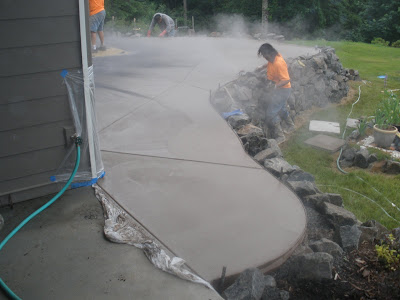


 I estimated being away from the lake for an hour giving me forty minutes to climb and twenty minutes to descend back to the lake. I really wanted to reach the summit but my years of backcountry trail running have taught me better, so I turned around. The rest of my family had gone down from the lake back to the trailhead as I headed up. I discussed being about an hour behind them, and being in unfamiliar grizzly country with a possible wet thunder shower coming soon I felt it best to head back. I reached the lake in twenty minutes pounding carefully down the hillside. Passing several hikers I soon reached my descending family roughly one hundred meters shy of the trailhead right as the rain started to fall.
I estimated being away from the lake for an hour giving me forty minutes to climb and twenty minutes to descend back to the lake. I really wanted to reach the summit but my years of backcountry trail running have taught me better, so I turned around. The rest of my family had gone down from the lake back to the trailhead as I headed up. I discussed being about an hour behind them, and being in unfamiliar grizzly country with a possible wet thunder shower coming soon I felt it best to head back. I reached the lake in twenty minutes pounding carefully down the hillside. Passing several hikers I soon reached my descending family roughly one hundred meters shy of the trailhead right as the rain started to fall.
Today is a July 14, 2011 and marks our third day in beautiful Gallatin, Montana. Yesterday we walked to see the unfishable flooded Gallatin River, hiked a few miles along Swan Creek where Gabe earned $1 from Jim for jumping into a deep section formed by an old beaver dam and fished Squaw Creek; we were skunked by the way. Even so Jon had a few fish rise to the flies he presented. Jonathan has been here for a few days celebrating his “double digit” birthday with Cheryl’s Uncle Jim, Aunt Linda and Cousin Carly. The cabin along the Gallatin River has been in the Robbins family since Jim’s parents purchased the three acre plot and simple structure in 1968. The cabin has doubled in size with more modern additions, but still remains rustic and romantic. Cheryl has been here many times as a child and young adult with her family; this is my second visit and the first for the boys. The cabin sits roughly in the center of Castle Meadow, a large long grassy stretch bordered on the east side by I-151 and on the west by the Gallatin River. This is our base camp for all our adventures.





 While we fished Gabe, Linda, Carly and Cheryl spent the day in Yellowstone. Geysers, paint pots, hot springs, bison and bears were the highlights of the day.
While we fished Gabe, Linda, Carly and Cheryl spent the day in Yellowstone. Geysers, paint pots, hot springs, bison and bears were the highlights of the day.
The next day I had the opportunity to spend time fishing with Jim, cashing in my Christmas coupon for one free day of fishing in Montana. We set out late in the morning after a blueberry pancake breakfast while the rest of the group went off to visit a couple antique and thrift shops. Jim had scouted out the best waters for a one day wading trip. We settled on fishing the Gibbon River in West Yellowstone and waiting for suggestions from the Blue Ribbon Fly Shop at the west entrance for more information. 



The next morning we woke early, said our goodbyes and headed off for the thirteen hour drive home. On the way we stopped to fish in the St Regis river before leaving Montana, refuled and found amazing ice cream in Wallace, Idaho, played a much needed round of "Flyers Up" at a rest stop in Moses Lake. and grabbed a Subway dinner in Ellensburg.
Tony









 After the pour they covered the top with a black powder and pounded the mats to set the
After the pour they covered the top with a black powder and pounded the mats to set the 


 Tony
Tony





